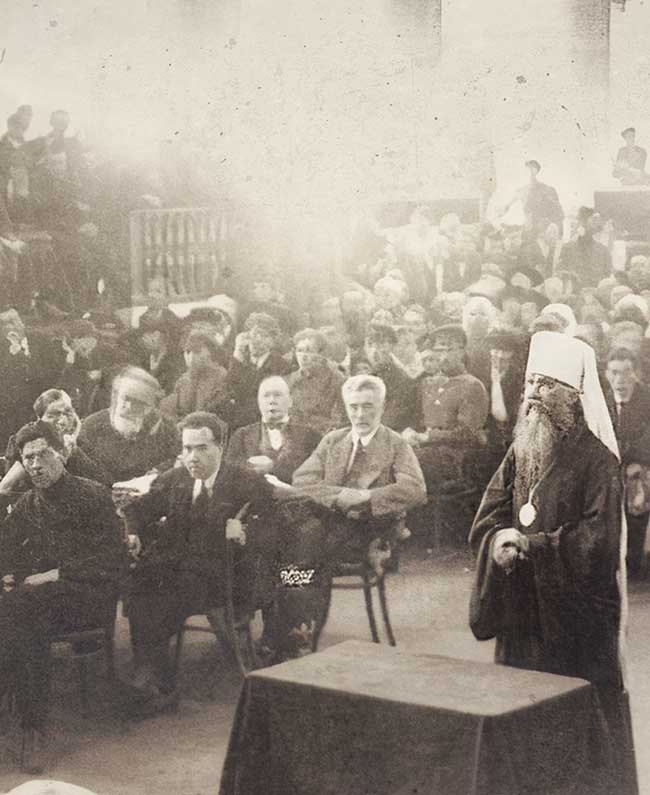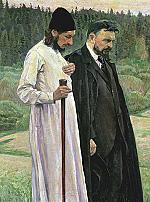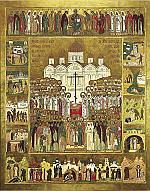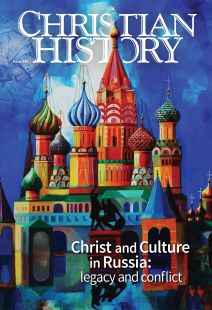Christian lives and Christian hope

[Session of Petrograd Revolutionary Tribunal on the Case of Metropolitan Veniamin, 1922. Courtesy of St. Petersburg Encyclopedia]
If there was a battle between God and the Soviets, God won.
The atheist regime tried hard to replace religion with atheism, closing churches and arresting believers (see pp. 6–11). Some believed faith would fade away as communism progressed. That did not happen. Religion remained part of life among a significant minority of Soviet citizens. Christianity and other religious worldviews, including Eastern religions and Buddhism, grew stronger as they attracted intellectuals raised in atheist families. Cracks formed in the regime, evidenced most prominently when Soviet authorities decided to allow the Russian Orthodox Church to celebrate the Millennium of the Baptism of Rus in 1988 (see pp. 38–41).
Some stories of believers in the USSR tell of martyrdom, suffering, and innocent deaths of hundreds of thousands. Others point out strategies for the survival of institutional Christianity, arguing that without compromising with power, the church would not have survived. Many Christian believers who lived under the state’s pressure suffered death and violence, though others survived without making a deal with the authorities. How did they understand their witness? What did it mean for them to be Christians in times of faithlessness and persecution? How did they live their lives as Christians?
Destructive change (1917 to 1940s)
The assault of the Bolsheviks from the early years of Soviet power until the Second World War led to the demolition of the institutional structures of the Russian Orthodox Church, the largest Christian organization. By the beginning of World War II in the USSR, only four Orthodox bishops were alive and not imprisoned, and not a single functioning monastery existed. The head of the church, Patriarch Tikhon, had died broken in 1925 (see pp. 43–47).
It began in the villages. Stalin’s collectivization did not simply mean the replacement of private farming with state collective farms; it attacked the village culture and way of life. As one of the pillars of rural popular religion, the Orthodox parish was a site of resistance and a real threat to collectivization.
When Aleksander Vorobiev (d. 1937), a pious Orthodox man and father of 11 children, became the head of the parish council in the 1920s in the village of Kamennoe Ozero in the Urals, he knew that the future of the parish depended on him and his fellow parishioners. He tried to keep the church open as long as possible but could not resist the armed groups of the local militia who closed the parish church in 1936.
Vorobiev started a campaign to reopen the church and sent numerous petitions and complaints to the state authorities in Moscow. At age 82 he was arrested and tried as a member of the fictitious “counter-revolutionary fascist terrorist organization of the church people in the Urals.” Five women, all members of the church council, were also arrested and tried with him; so was the parish priest. All seven were executed in the prison of Yekaterinburg in 1937, and their property was confiscated.
Historians estimate the number of victims of Stalinism —those who were arrested, executed, imprisoned, exiled, and deported—at 60 million. The labor camps—spread over the vast territories of the north of Russia, Siberia, and the far east—served as places of detention, reeducation, and extermination of groups deemed enemies of the people. Believers in the gulag (see p. 1) made a special category.
Witness in the camps
Olga Iafa (1876–1964), an educated noblewoman from St. Petersburg, was 51 when she was arrested in 1929 and sent to the gulag. She spent three years in the labor camp in Solovki. Her reminiscences and literary works about Solovki remain an important witness to the life of Christians in the camps.
Believers typically had two approaches to life as camp laborers. Some chose the path of martyrdom and refused to contribute to the Soviet economy through work. When arrested and sent to Solovki, for example, nuns from Shamordino, a monastery founded by Amvrosy of Optina, refused to work for what they saw as “the Antichrist” and received a severe punishment. Other believers tried to reason with the nuns and help them to avoid their fates, but the women were determined to follow the will of their spiritual father, Amvrosy, and suffer martyrs’ deaths.
Olga Iafa highlighted the other approach to witness in the camp. She recollected how 14 Orthodox and Roman Catholic bishops performed heavy work duties in the camps during Holy Thursday:
United in one common effort they walked shoulder to shoulder—one still young short-sighted Catholic bishop, shaved and in round glasses, and a gaunt, weary, white-bearded Orthodox bishop, decrepit in his day, but strong in spirit, pushing with unrelenting zeal on the cart.
Normally on that day, according to Orthodox tradition, bishops participated in the ritual of footwashing, symbolizing humility. In Solovki they showed humility to the people of the camp through their acceptance of unjust punishment. This particular approach deeply affected Iafa. In her novella Mother Veronika, she wrote of how work and service to the people could be a form of Christian witness.
Veronika, a nun, is proud and self-centered, striving for recognition as an exemplary Christian. When she is arrested and given a sentence, she makes a prostration in gratitude, much to the amusement of the guards. But, while in the camps, she learns true Christian humility through her alienation from other people. She sheds her pride and ambitions through self-negation—working in the hospital and looking after the sick and dying. Her transformation is visible to people around her who seek her counsel and receive grace.
Finding meaning in suffering and privations is a recurring theme of gulag literature. Aleksandr Solzhenitsyn (1918–2008) famously wrote in Gulag Archipelago: “Since then I have come to understand the truth of all the religions of the world: They struggle with the evil inside a human being (inside every human being). It is impossible to expel evil from the world in its entirety, but it is possible to constrict it within each person.”
Choosing the lesser evil
The restoration of the institutional structures of the church during the Second World War changed Christian witness. USSR religious life experienced revival during and after the war: many churches were open, and new territories that were either outside of the USSR or occupied by the Germans experienced a religious renaissance. The number of clergy and churches almost doubled after the war. Demand for religious sacraments rose immensely among people affected by war and repression. In one provincial parish (Kuibyshev) in only one year (1944), there were 20,403 officially registered baptisms—56 each day!
Still, during the war, Orthodox Christians had to make a difficult choice between Stalin and Hitler. While many welcomed the religious policy of the Third Reich, which restored churches in occupied territories, they could not reconcile Nazi violence against Jews. In 1942 Germans executed the mayor of Kremechuk because, together with a local priest, he helped Jews to get Christian names to be saved from the Holocaust.
But after Stalin’s death in 1953, hopes were high. Many believers, priests, and bishops were released from the camps; they preached the gospel and served as spiritual guides. Even so the church remained under close surveillance of the state and was sometimes a tool of the KGB, which maintained a huge apparatus of agents and informants.
Soviet propaganda continued to boast that the Soviet people held a uniform worldview, materialistic and ideologically streamlined with the policies of the Communist Party. Underneath the surface, however, a different life was thriving. Individuals and groups began to form a religious underground, the catacomb church, which existed both in the countryside and in the cities. It consisted of believers, monks, nuns, bishops, and priests who disaffiliated themselves from the church hierarchy led by Patriarch Sergei (Stragorodsky, 1867–1944). The religious underground had an alternative hierarchy, with clandestine chapels and churches and secret hideaways for the clergy. The state security police searched viciously for these clusters of religious life. The network of the catacomb church covered the entirety of the USSR, spanning western Ukraine to Siberia, and the persecutions of these believers raged from the 1920s to 1987.
In addition to the illegal catacomb church, another form of religious resistance emerged within the “official” church. Some informal monastics who lived “in the world” had jobs in Soviet institutions, but they took monastic vows and lived out a hidden but intense spiritual life under the guidance of spiritual fathers and mothers. Members of these secret monastic networks worked during the day in Soviet institutions, but at night read the Gospel and ascetic books, corresponded with elders, and copied the sayings of spiritual elders from nineteenth-century books.
Valentina Puzik (1903–2004), a professor and head of a laboratory at the Central Tuberculosis Institute in Moscow, lived this secret double life. No one knew at the time, but the renowned professor was also a nun under the name Ignatia, having taken monastic vows when she was 21 years old. She turned to God under the influence of a charismatic monk, Agathon of the Petrovsky Monastery in Moscow, where the tradition of spiritual guidance and eldership was preserved. Her spiritual father died of pellagra in a Stalinist camp, but Mother Ignatia preserved his legacy. She wrote books about asceticism, preserved letters and documents from her spiritual father, composed hymns and prayers, and supported younger women who sought spiritual counsel.
The age of complicity (1960s to 1980s)
The uneasy compromise between the church hierarchy and the Soviet state became more transparent during the years of the Cold War, when the bishops of the Russian Orthodox Church served Soviet foreign policy, participating in delegations to Western international institutions.
Metropolitan Filaret (Vakhromeev, 1935–2021), important in the church from the 1960s to 1980s, later wrote that
the Russian Orthodox Church has participated with a clear conscience in the all-Union and worldwide peacemaking movement, and I hold this movement in high esteem. I can assume that today it is hard to believe how often and how close to the edge of the nuclear abyss the human race found itself during the second half of the twentieth century. . . . Friendship societies with the peoples of other countries, peacemaking forums on a regional and planetary scale, and national peace movements quite naturally included the peacemaking mission of the Church.
Yet popular religious movements and intellectuals resisted the compromise. On the ground rural priests and parish activists organized pilgrimages, carried out services, and maintained a network of Christians all over the USSR. At the same time, collectivization had subverted the base of Christian life in the villages, and it never fully recovered. Due to urbanization processes in the 1960s, a massive outflow of younger people from the countryside meant that Orthodoxy in Russia’s rural regions was dying.
Cities and seekers
City intelligentsia who came to faith in the late 1950s and 1960s led a religious revival, although limited in scale. Educated youth began to explore religious philosophy. Hoping to avoid interference from the authorities, young men and women seeking spiritual guidance flocked to popular preachers and spiritual elders, such as Aleksandr Men (1935–1990), who served in the village of Semkhoz, 43 miles from Moscow (see pp. 43–47).
Another popular site was the provincial Pskovo-Pechersky Monastery where Archimandrite Ioann Krestjankin (1910–2006) provided spiritual counsel to educated young men, many of whom became priests.
These questioning members of the intelligentsia formed small discussion groups, circles, and religious-philosophical seminars in the 1970s. They tended to lean toward clergy with a similar background and intellectual outlook, including Orthodox priests such as Men. These priests carried out missionary work among the intelligentsia, catechizing and baptizing adults, and drawing on world literature, the arts, and music to convey the gospel to Soviet-educated seekers.
Disregarding the ideological differences between “democrats” and “nationalists,” the missionary clergy used pastoral methods of the Russian Orthodox Church that remained traditional even as they innovated. They employed the traditional teachings of the church fathers, combining them with universalist and ecumenical currents.
The traditional personal relationship between pastor and neophyte, based on the model of spiritual fatherhood, was especially valuable in developing personal ties between the members of these dissident or semidissident circles around the parishes of Men’s church in Novaia Derevnia, Vsevolod Shpiller’s Nikolaevskaya Church in Kuznetsy (Moscow), or Dmitri Dudko’s commune in Grebnevo, 24 miles outside Moscow.
Men was a popular pastor to Christian intellectuals. He compared his role as a pastor with that of a midwife, saying that he only wanted to help the person to find his or her own way to God: “What is born from within is more valuable than what is brought from without.”
The new political investment in the antireligious campaigns of the Khrushchev era and the destructive policies used against the institutions and personnel of the Russian Orthodox Church led the church hierarchy to push conformity, but dissent emerged instead among the lower ranks of the clergy and the intelligentsia.
Some vociferous priests accused the hierarchy of cowardice and complicity and criticized its neglect of the reformist spirit of the All-Russian Church Council of 1917–1918. In 1972, Solzhenitsyn adopted a similar position in his open “Great Lent Letter” addressed to Patriarch Pimen. He lamented the devastation of religious life in Russia and blamed the hierarchy for its silence, passivity, and submissiveness to the destroyers of the church.
In the late 1970s and 1980s, dissident and informal movements took up the call to Christian witness—such as hippies, who rediscovered the gospel after reading philosophical books and listening to Western music, most notably Andrew Lloyd Weber’s rock opera, Jesus Christ Superstar. These long-haired men, calling themselves Jesus People, dropped out of universities, camped beside Latvian lakes and in forests, or gathered in the Moscow apartments of Aleksandr Ogorodnikov (b. 1950) and Vladimir Poresh (1949–2022). The priest Dmitrii Dudko (1922–2004) baptized some of them in his kitchen rather than in church.
They planned seminars and “happenings”: for example, Ogorodnikov staged the mock ballet Lenin Superstar. They published samizdat (clandestine) journals. Some rediscovered Orthodoxy and saw themselves as intellectual descendants of the nineteenth-century saints and theologians; others were in favor of ecumenical relations with other Christians, especially Roman Catholics. Several young men with hippie backgrounds became priests. In the late 1970s, many members of these informal Christian groups were arrested and received prison sentences or were sent to psychiatric hospitals.
The late 1970s through the 1980s saw even greater militarization, political polarization, and ideological control within the communist bloc. Christians had a presence in the communitarian, pacifist, and feminist movements in the late Soviet Union. Most of the Soviet hippies supported nonviolent resistance, and some embraced the teachings of Leo Tolstoy against war.
Tolstoyan groups together with Jesus People and Christian feminists protested the war in Afghanistan (1979–1989). The members of these informal groups identified themselves and their way of life with the early Christians, amalgamating the hippies’ lifestyles with the forms of a Christian community. Not all of them managed to withstand the pressure of the authorities: Dudko, after his arrest in 1980, publicly renounced his views and denied that persecution of dissidents even existed.
Choices and silence
History made a full circle: today the Russian Orthodox Church is no longer persecuted by the state authorities. It has experienced a remarkable revival in the last 30 years. A generation of Orthodox Christians grew up in a country where people were not penalized for their faith in God.
However, the current alliance of the church hierarchy with the Putin regime raises questions about what we can learn from the past. The bishops do not oppose the war and injustice. But there are clergy and laity who actively resist the war, morally corrupt authority, lies, and political violence. Some of them are imprisoned or in exile. They are successors of the martyrs and confessors of the previous era. CH
By Irina Paert
[Christian History originally published this article in Christian History Issue #146 in 2023]
Irina Paert is senior researcher at the School of Theology and Religious Studies at the University of Tartu and the author of Old Believers, Religious Dissent and Gender in Russia 1760–1850 and Spiritual Elders.Next articles
A diversity of witnesses
Some Scholars, church leaders, mission workers, and martyrs forming modern Orthodoxy in Russia
Jennifer A. BoardmanSupport us
Christian History Institute (CHI) is a non-profit Pennsylvania corporation founded in 1982. Your donations support the continuation of this ministry
Donate







